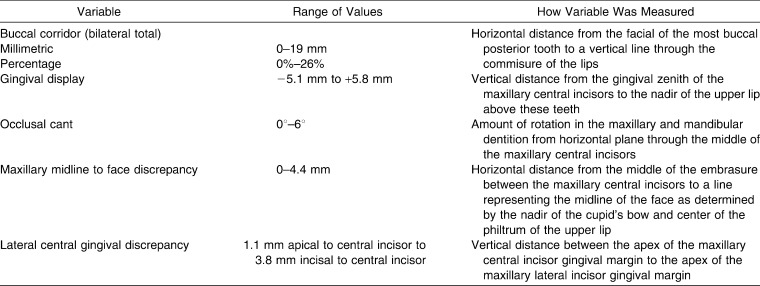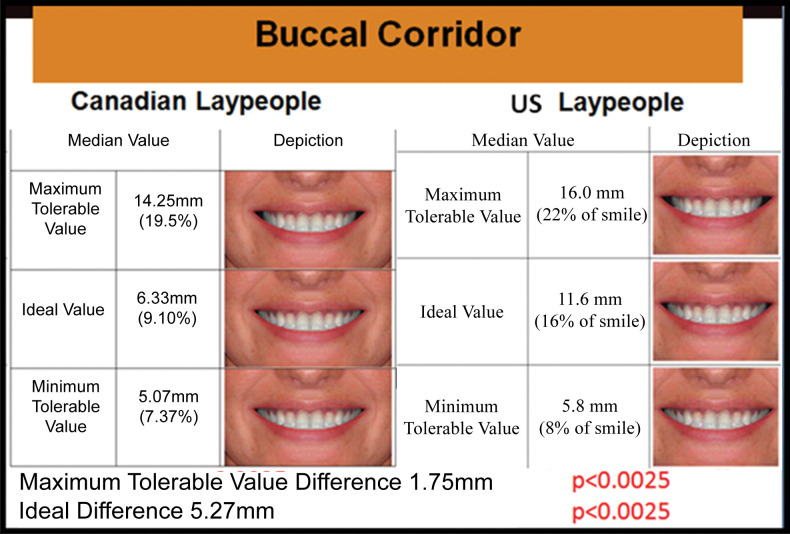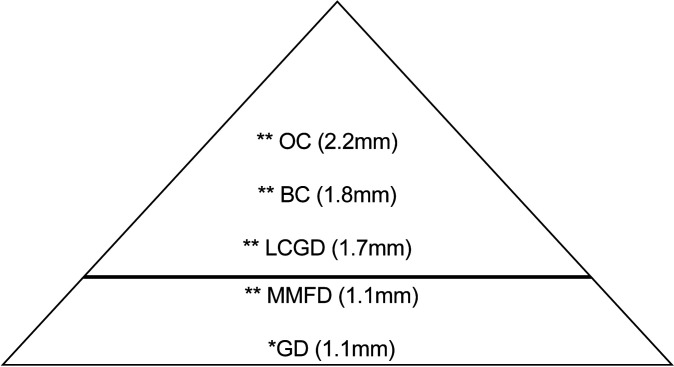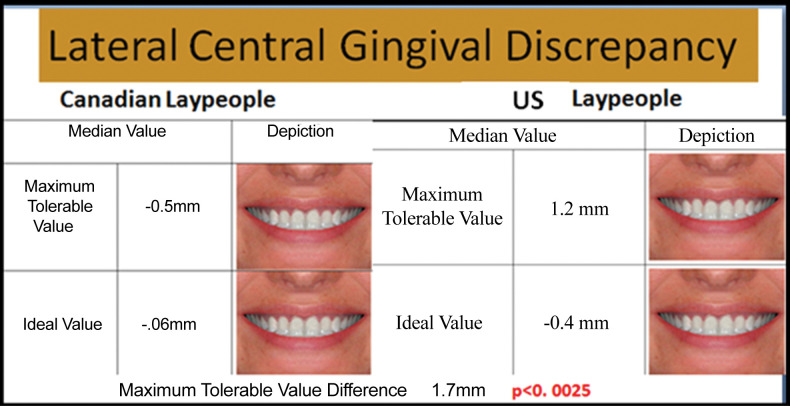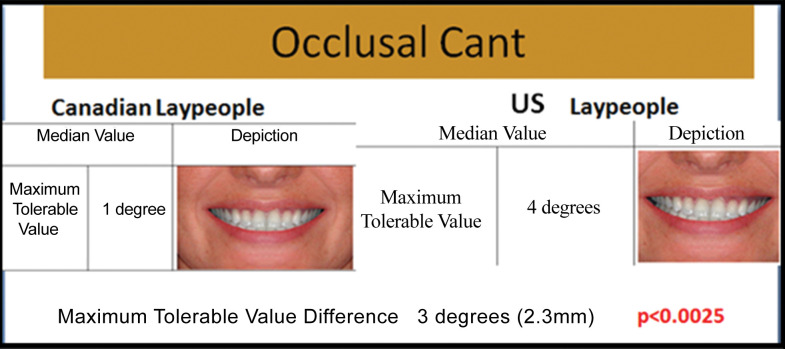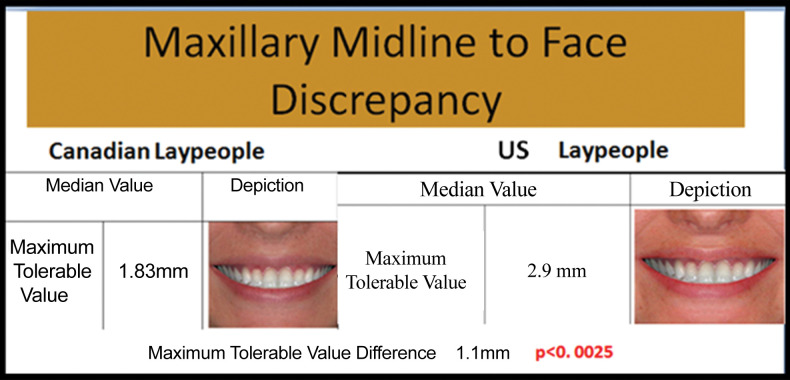Abstract
Objective:
To collect data regarding Canadian laypersons' perceptions of smile esthetics and compare these data to US data in order to evaluate cultural differences.
Materials and Methods:
Using Adobe Photoshop 7, a digital image of a posed smile of a sexually ambiguous lower face was prepared so that hard and soft tissue could be manipulated to alter buccal corridor (BC), gingival display (GD), occlusal cant (OC), maxillary midline to face discrepancy (MMFD), and lateral central gingival discrepancy (LCGD). Adult Canadian laypersons (n = 103) completed an interactive computer-based survey of 29 randomized images to compare smile preferences for these variables. The custom survey was developed to display fluid, continuously appearing modifiable smile variables using MATLAB R2008 for presentation. These data were compared with previously published data for US laypersons. Statistical inference was determined using Wilcoxon rank sum tests.
Results:
Canadian laypersons were more sensitive in detecting deviations from ideal and had a narrower range of acceptability thresholds for BC, GD, OC, MMFD, and LCGD. Ideal esthetic values were significantly different only for BC.
Conclusions:
It appears that cultural differences do exist related to smile characteristics. Clinically significant differences in the preference of the smile characteristics were found between Canadian and US laypersons. Canadian laypersons, on average, were more discriminating to deviations from ideal and had a narrower range of acceptability.
Keywords: Smile esthetics, Acceptability, Buccal corridor, Gingival display, Occlusal cant, Maxillary midline to face discrepancy, Lateral central gingival discrepancy
INTRODUCTION
An esthetic smile is the result of the interaction of different smile components1 and requires an understanding of the principles that manage the balance between teeth and soft tissues.2 Establishing ideal function and esthetics may be mutually exclusive and requires careful and detailed consideration during orthodontic treatment planning.
Smile esthetics have been researched using a variety of perspectives and methods.3–6 Kokich et al.4 were the first to systematically quantify orthodontists' and laypersons' perceptions of smiles by using static photos of posed smiles adjusted incrementally. Dental professionals and laypersons had different perceptions of smile esthetics and were able to identify characteristics that both enhanced and detracted from smile esthetics.3–5 Ker et al.7 comprehensively investigated perceptions of smiles along a continuous range, where the evaluator digitally modified smiles using a mouse-driven slider to select the most ideal and the thresholds of acceptability.7
A number of variables influence the attractiveness of a smile. Buccal corridor minimization is a critical smile feature,4,6,8–10 excessive gingival display does not appear to be well tolerated by raters,4 and maxillary midline deviations can upset the balance of an otherwise esthetic smile.8,9 Kokich et al.4 found an occlusal cant was detrimental to smile esthetics.4 In addition, the location, shape, and contour of the gingiva in the maxillary anterior region also affects smile esthetics.10
Individual and cultural characteristics must be considered in smile evaluation.11 Although there are data from another ethnic group that deal with one aspect of smile esthetics (buccal corridor)12 and show similar preferences to US raters, to this point, no study has comprehensively examined whether differences in cultural/national background can alter the perception of smile characteristics. Quantifying potential North American cultural differences in the perception of smile esthetics could reveal important considerations in achieving clinical success and patient satisfaction.
The purpose of this collaborative multicenter study was to incorporate slider technology and advanced digital-imaging methods to quantitatively determine and compare cultural/national smile esthetic preferences of Canadian and US laypersons.
MATERIALS AND METHODS
This collaborative research study was approved by a University Research Ethics Board and used identical digital images as those used by Ker et al.7 (permission granted by J Am Dent Assoc). The method of presentation was compatible with that research so that the data could be compared.7
Model Selection and Image Manipulation
Using Adobe Photoshop 7, a digital image of a posed smile of a sexually ambiguous lower face was manipulated to alter buccal corridor (BC), gingival display (GD), occlusal cant (OC), maxillary midline to face discrepancy (MMFD), and lateral central gingival discrepancy (LCGD) following the protocol of Ker et al.7 Raters completed an interactive computer-based survey of 29 randomly presented images. The custom survey was developed to compare smile preferences, which displayed fluid, continuously appearing modifiable smile variables using MATLAB R2008 (MATLAB R2008, The Mathworks Inc, Natick, Mass), a numerical computing environment, and programming language software. The raters selected the ideal and acceptability thresholds of several independent smile variables. Figure 1 illustrates an example of the filmstrip of maxillary OC changing from severe to less severe. The teeth and lip images appearing on the computer monitor were scaled to replicate clinical size at a typical conversational distance of 40 cm.7 The resolution was standardized on all computers at 1024 × 768 pixels. A digital measurement grid, calibrated to Wheeler's dental anatomy13 average value for a central incisor, was used for all smile characteristic digital modification. Ideals were inherent as zero for variables OC and MMFD and therefore not tested. Table 1 summarizes the range of possible values and the method of measurement.7
Figure 1.
Example of filmstrip of maxillary cant changing from severe to less severe. Ker AJ, Chan R, Fields HW, Beck M, Rosenstiel S. Esthetics and smile characteristics from the layperson's perspective: a computer-based survey study. J Am Dent Assoc. 2008;139(10):1318–1327. Copyright © 2008 American Dental Association. All rights reserved. Reprinted by permission.
Table 1.
Summary of Measurement of Smile Variables
Survey Design
Adult Canadian laypersons (n = 103; ie, the general public) were recruited at a central university facility and from the reception area of a dental college. They voluntarily completed an anonymous interactive computer-based survey. Surveys were individually administered, and each rater provided 36 responses: 29 randomly presented image-based responses (19 unique questions and 10 repeat questions to evaluate rater reliability) and seven demographic responses. Demographic information included Canadian geographical province of residence, age, gender, ethnic background, and level of education completed. Inclusion criteria for laypersons required that the evaluator must have lived in Canada for the past 5 years. Exclusion criteria included previous dental professional affiliations, orthodontic patients, or those related to orthodontic patients.
Image-based questions were presented with one of two questions: (1) “Select the image you find MOST IDEAL” or (2) “Please move the slider to the left to select the FIRST image that you find UNATTRACTIVE.” Question 1 was designed to determine the ideal value for each smile characteristic. Question 2 was designed to determine the acceptability thresholds when a smile characteristic becomes unattractive.
Statistical Analysis
Demographic variable comparisons were made using chi-square and t-tests. Relationships between the demographic variables and the outcome variables were evaluated with nonparametric correlation coefficients. To control for demographic differences between the two samples, confounding variables were controlled by stratifying gender, ethnicity, and educational background. Statistical inference was determined using Wilcoxon rank sum tests for comparison to Ker et al.,7 who used nonparametric statistics including median values. A Bonferroni-Holm correction was employed to control for type I error inflation due to multiple tests. Differences between the published US data7 and Canadian groups were evaluated, with the level of significance established at alpha = .05 for all analyses using statistical software (SAS, version 91.3, SAS Institute, Cary, NC). Differences in attractiveness ratings were analyzed using descriptive nonparametric statistics including median values. Power calculation confirmed the appropriateness of sample size capable of determining significant differences between all variables, as demonstrated by a 1-mm or 1-degree difference on the slider scale. Differences in reliability ratings were analyzed using the weighted Kappa statistic at a 95% confidence interval. For an alpha level of .05 and assuming a common standard deviation of 17.42,14 a sample size of 43 per rater group was necessary to achieve a power of .85 to determine statistically significant differences between all variables.
RESULTS
Intrarater reliability was excellent (Kappa = .98). The results therefore were deemed reliable.15
Frequency Distributions/Rater Demographics
Distribution by gender, ethnicity, and educational background for the 103 Canadian raters and the published US data are presented in Table 2. The Canadian sample consisted of more men, had a higher percentage of nonwhite participants, and had less postsecondary education. After stratifying by gender, ethnicity, and educational background, these three confounding factors were not predictive of the five smile characteristic preferences in either group and were considered comparable.
Table 2.
Frequency Distribution of Demographic Variables by Evaluator Group
National Differences Defining Ideal and Acceptable Smile Characteristics
The descriptive numeric results and corresponding image depiction for each smile characteristic defined as ideal and their acceptable limits are reported using medians and associated images in Figures 2 through 7. Cultural/national differences of less than 1 mm were not considered clinically significant.
Figure 2.
Summary of statistics for defining the ideal and acceptable smile characteristics: buccal corridor. Ker AJ, Chan R, Fields HW, Beck M, Rosenstiel S. Esthetics and smile characteristics from the layperson's perspective: a computer-based survey study. J Am Dent Assoc. 2008;139(10):1318–1327. Copyright © 2008 American Dental Association. All rights reserved. Reprinted by permission.
Figure 7.
Hierarchy of differences between the US and Canadian median maximum tolerable limit of acceptability. In each case, the Canadian raters were less tolerant of deviations from the ideal than US raters. * P < .05; ** P < .0025.
Figure 4.
Summary of statistics for defining the ideal and acceptable smile characteristics: lateral central gingival discrepancy. Ker AJ, Chan R, Fields HW, et al. Esthetics and smile characteristics from the layperson's perspective: a computer-based survey study. J Am Dent Assoc. 2008;139(10):1318–1327. Copyright © 2008 American Dental Association. All rights reserved. Reprinted by permission.
Figure 5.
Summary of statistics for defining the ideal and acceptable smile characteristics: occlusal cant. Ker AJ, Chan R, Fields HW, Beck M, Rosenstiel S. Esthetics and smile characteristics from the layperson's perspective: a computer-based survey study. J Am Dent Assoc. 2008;139(10):1318–1327. Copyright © 2008 American Dental Association. All rights reserved. Reprinted by permission.
DISCUSSION
Patients are becoming more critical of their smile esthetics and are seeking orthodontic treatment with more refined expectations.16 This study focused on esthetic ratings of smile characteristics evaluated by laypersons as they are the primary consumer of orthodontic services, and satisfaction with treatment depends on patient expectations. The results demonstrate that laypersons can reliably identify the ideal and the ranges of acceptability when using a lower face perspective. This finding strengthens the power of this methodology. The demographic variables were significantly different between the samples for gender, ethnicity, and educational background (Table 2). As a result, a stratified analysis was necessary to reduce the probability that these variables confounded the results. The demographic variables were not predictive of the smile outcomes. This eliminated demographic variables as potential confounders and allowed the US and Canadian groups to be compared.
These results revealed that Canadian and US laypersons' preferences differed statistically and clinically in their perceptions of all smile characteristics tested. With the exception of the ideal BC, the differences were focused on maximum tolerable differences. Canadian and US orthodontists should not assume that all patients in North America are equally critical of their smile esthetics, nor do they necessarily have similar smile esthetic preferences.
This study demonstrated that different cultures/nationalities can provide different smile preferences for multiple variables. The hierarchy of differences between the groups at the maximum tolerable limit of acceptability is illustrated in decreasing order in Figure 7. Other emerging comprehensive cultural studies of smiles suggest that BC and smile arc can have cultural differences.17 It appears that variables related to the face as a context may be most affected. These emerging cultural differences may be a factor because given the flood of stimuli, it appears that different cultures may allocate their attention differently.18 More investigation on cultural influences is warranted so this potential confounding research variable can be eliminated.
Statistically significant results do not necessarily infer noticeable therapeutic effects. Given substantial sample power and the methodology used, small differences can be unrealistically amplified. The lower face view used in this study may have facilitated the detection of small clinical differences compared with a full-face perspective. As a result, the lower limit of clinical significance threshold was set at 1 mm. A similar focusing effect of the slider technology, likewise, may have heightened attention on the variables.
BC reduction is particularly relevant today, with the trend toward broader arch forms and nonextraction treatment.12 Canadian raters' definition of ideal BC (Figure 2) agrees with this trend, preferring approximately 7% less dark space (5.3 mm) than the US raters. This was the only variable for which ideal esthetic values were defined as significantly different, statistically and clinically. Improving excessive BC in Canada may be a more important treatment objective than in the United States.
There is no consensus on the degree to which GD influences smile esthetics.4,19,20 National differences fell within a prereported range of acceptability. Two separate studies by Kokich et al.4 suggested that ±4 mm of GD was the threshold of acceptability evaluated by laypersons and dentists collectively, whereas the threshold of ±3 mm evaluated by laypersons and orthodontists was suggested after testing smaller increments.19 The more recent US results found that the ideal value for GD was 2.1 mm of incisor coverage, consistent with Van der Geld et al.,21 who reported ±4 mm within the range of acceptability.4,7 The Canadian data (Figure 3) are consistent with the more recent study by Kokich et al.19 indicating that a narrower range of ±3 mm is within the range acceptability.
Figure 3.
Summary of statistics for defining the ideal and acceptable smile characteristics: gingival display. Ker AJ, Chan R, Fields HW, Beck M, Rosenstiel S. Esthetics and smile characteristics from the layperson's perspective: a computer-based survey study. J Am Dent Assoc. 2008;139(10):1318–1327. Copyright © 2008 American Dental Association. All rights reserved. Reprinted by permission.
Studies regarding OC show that a range exists from 2°,22 3°,23 to 4°7 from true horizontal where OC is acceptable to laypeople, and beyond which asymmetries become noticeable. The differences between Canadian and US laypersons' perceptions of OC were the most evident of all the smile characteristics investigated. Canadians were the most sensitive, to date, in detecting deviations from ideal at 1° (Figure 6). To translate that to millimeters and to our threshold for clinical significance, a 3° difference is approximately 2.3 vertical millimeters at the lateral border of an average-width smile. With this clinically significant difference between Canadian and US laypersons, US orthodontists have more latitude in the finishing stages of treatment for OC.
Figure 6.
Summary of statistics for defining the ideal and acceptable smile characteristics: maxillary midline to face discrepancy. Ker AJ, Chan R, Fields HW, Beck M, Rosenstiel S. Esthetics and smile characteristics from the layperson's perspective: a computer-based survey study. J Am Dent Assoc. 2008;139(10):1318–1327. Copyright © 2008 American Dental Association. All rights reserved. Reprinted by permission.
Midline discrepancies are the most obvious occlusal asymmetries from the patient's perspective.8 Noticeable MMFD by laypersons is reported as minor as 2-mm24 or as much as 4-mm deviations.4 Inconsistencies in the Canadian and US data for midlines also appears to be a function of underlying cultural/nationality differences (Figure 6). Canadians identified the threshold of an acceptable midline deviation 1.1 mm before the deviation was perceivable to US laypersons.
Management of the periodontal tissues that frame each tooth is crucial to esthetic smile design.25 Differences in ethnic background contributed toward the differences revealed in perceptibility of LCGD. Canadians were less willing to accept deviations from ideal than were US raters. The US data7 corroborated previous results by Kokich et al.,4 in that the US laypersons did not readily notice LCGD even when the lateral gingival margin is superior to the central gingival margin. US laypersons had great variability in their limit of acceptability, as demonstrated by the broad range of acceptability.
Both Canadian and US orthodontists need to discuss the potential limitations of orthodontic treatment in order to make a decision in concert with the patient as to what tradeoffs are acceptable in the pursuit of the ideal smile.26 These results provide significant insights of posttreatment satisfaction and may be a predictor of the patients' objectives when undergoing a particular treatment.
CONCLUSIONS
Laypersons can reliably identify the ideal and the ranges of acceptability when using a lower face view of models.
Individual perception of smile esthetics influenced by national/cultural background can affect multiple variables in unequal ways and must be considered in research and clinical settings.
Canadian laypersons, on average, were more sensitive to deviations from ideal and had a narrower range of acceptability.
REFERENCES
- 1.Gracco A, Cozzani M, D'Elia L, Manfrini M, Peverada C, Siciliani G. The smile buccal corridors: aesthetic value for dentists and laypersons. Prog Orthod. 2006;7:56–65. [PubMed] [Google Scholar]
- 2.Gul E. E, Fida M. Changes in smile parameters as perceived by orthodontists, dentists, artists, and laypeople. World J Orthod. 2008;9:132–140. [PubMed] [Google Scholar]
- 3.Moore T, Southard K. A, Casko J. S, Qian F, Southard T. E. Buccal corridors and smile esthetics. Am J Orthod Dentofacial Orthop. 2005;127:208–213. doi: 10.1016/j.ajodo.2003.11.027. [DOI] [PubMed] [Google Scholar]
- 4.Kokich V. O, Jr, Kiyak H. A, Shapiro P. A. Comparing the perception of dentists and lay people to altered dental esthetics. J Esthet Dent. 1999;11:311–324. doi: 10.1111/j.1708-8240.1999.tb00414.x. [DOI] [PubMed] [Google Scholar]
- 5.Parekh S. M, Fields H. W, Beck M, Rosenstiel S. Attractiveness of variations in the smile arc and buccal corridor space as judged by orthodontists and laymen. Angle Orthod. 2006;76:557–563. doi: 10.1043/0003-3219(2006)076[0557:AOVITS]2.0.CO;2. [DOI] [PubMed] [Google Scholar]
- 6.Wong N. K, Kassim A. A, Foong K. W. Analysis of esthetic smiles by using computer vision techniques. Am J Orthod Dentofacial Orthop. 2005;128:404–411. doi: 10.1016/j.ajodo.2005.02.012. [DOI] [PubMed] [Google Scholar]
- 7.Ker A. J, Chan R, Fields H. W, Beck M, Rosenstiel S. Esthetics and smile characteristics from the layperson's perspective: a computer-based survey study. J Am Dent Assoc. 2008;139:1318–1327. doi: 10.14219/jada.archive.2008.0043. [DOI] [PubMed] [Google Scholar]
- 8.Nanda R, Margolis M. J. Treatment strategies for midline discrepancies. Semin Orthod. 1996;2:84–89. doi: 10.1016/s1073-8746(96)80046-6. [DOI] [PubMed] [Google Scholar]
- 9.Arnett G. W, Bergman R. T. Facial keys to orthodontic diagnosis and treatment planning—part II. Am J Orthod Dentofacial Orthop. 1993;103:395–411. doi: 10.1016/s0889-5406(05)81791-3. [DOI] [PubMed] [Google Scholar]
- 10.Sarver D. M. Principles of cosmetic dentistry in orthodontics: part 1. Shape and proportionality of anterior teeth. Am J Orthod Dentofacial Orthop. 2004;126:749–753. doi: 10.1016/j.ajodo.2004.07.034. [DOI] [PubMed] [Google Scholar]
- 11.Mahshid M, Khoshvaghti A, Varshosaz M, Vallaei N. Evaluation of “golden proportion” in individuals with an esthetic smile. J Esthet Restor Dent. 2004;16:185–192. doi: 10.1111/j.1708-8240.2004.tb00032.x. [DOI] [PubMed] [Google Scholar]
- 12.Ioi H, Nakata S, Counts A. L. Effects of buccal corridors on smile esthetics in Japanese. Angle Orthod. 2009;79:628–633. doi: 10.2319/080708-410.1. [DOI] [PubMed] [Google Scholar]
- 13.Wheeler R. C. The Permanent Maxillary Incisors; The Permanent Mandibular Incisors. In: Wheeler R. C, editor. A Textbook of Dental Anatomy and Physiology. Philadelphia, PA: WB Saunders; 1958. pp. 130–138. [Google Scholar]
- 14.Maple J. R, Vig K. W, Beck F. M, Larsen P. E, Shanker S. A comparison of providers' and consumers' perceptions of facial-profile attractiveness. Am J Orthod Dentofacial Orthop. 2005;128:690–696. doi: 10.1016/j.ajodo.2004.09.030. [DOI] [PubMed] [Google Scholar]
- 15.Landis J. R, Koch G. G. The measurement of observer agreement for categorical data. Biometrics. 1977;33:159–174. [PubMed] [Google Scholar]
- 16.Hiemstra R, Bos A, Hoogstraten J. Patients' and parents' expectations of orthodontic treatment. J Orthod. 2009;36:219–228. doi: 10.1179/14653120723247. [DOI] [PubMed] [Google Scholar]
- 17.Sharma N, Rosenstiel S. F, Fields H. W, Beck F. M. Layperson's esthetics and smile characterization between Caucasian and Indian populations. J Dent Res. 2010;89(special issue B):3626. [Google Scholar]
- 18.Matsuda Masuda T, Ellsworth P. C, Mesquita B, Leu J, Tanida S, Van de Veerdonk E. Placing the face in context: cultural differences in the perception of facial emotion. J Pers Soc Psychol. 2008;94:365–381. doi: 10.1037/0022-3514.94.3.365. [DOI] [PubMed] [Google Scholar]
- 19.Kokich V. O, Kokich V. G, Kiyak H. A. Perceptions of dental professionals and laypersons to altered dental esthetics: asymmetric and symmetric situations. Am J Orthod Dentofacial Orthop. 2006;130:141–151. doi: 10.1016/j.ajodo.2006.04.017. [DOI] [PubMed] [Google Scholar]
- 20.Ritter D. E, Gandini L. G, Jr, Pinto Ados S, Ravelli D. B, Locks A. Analysis of the smile photograph. World J Orthod. 2006;7:279–285. [PubMed] [Google Scholar]
- 21.Van der Geld P, Oosterveld P, Van Heck G, Kuijpers-Jagtman A. M. Smile attractiveness: self-perception and influence on personality. Angle Orthod. 2007;77:759–765. doi: 10.2319/082606-349. [DOI] [PubMed] [Google Scholar]
- 22.Geron S, Atalia W. Influence of sex on the perception of oral and smile esthetics with different gingival display and incisal plane inclination. Angle Orthod. 2005;75:778–784. doi: 10.1043/0003-3219(2005)75[778:IOSOTP]2.0.CO;2. [DOI] [PubMed] [Google Scholar]
- 23.Peck S, Peck L. Selected aspects of the art and science of facial esthetics. Semin Orthod. 1995;1:105–126. doi: 10.1016/s1073-8746(95)80097-2. [DOI] [PubMed] [Google Scholar]
- 24.Cardash H. S, Ormanier Z, Laufer B. Z. Observable deviation of the facial and anterior tooth midlines. J Prosthet Dent. 2003;89:282–285. doi: 10.1067/mpr.2003.68. [DOI] [PubMed] [Google Scholar]
- 25.Bitter R. N. The periodontal factor in esthetic smile design—altering gingival display. Gen Dent. 2007;55:616–622. [PubMed] [Google Scholar]
- 26.Sarver D. M, Ackerman M. B. Dynamic smile visualization and quantification: part 2. Smile analysis and treatment strategies. Am J Orthod Dentofacial Orthop. 2003;124:116–127. doi: 10.1016/s0889-5406(03)00307-x. [DOI] [PubMed] [Google Scholar]




